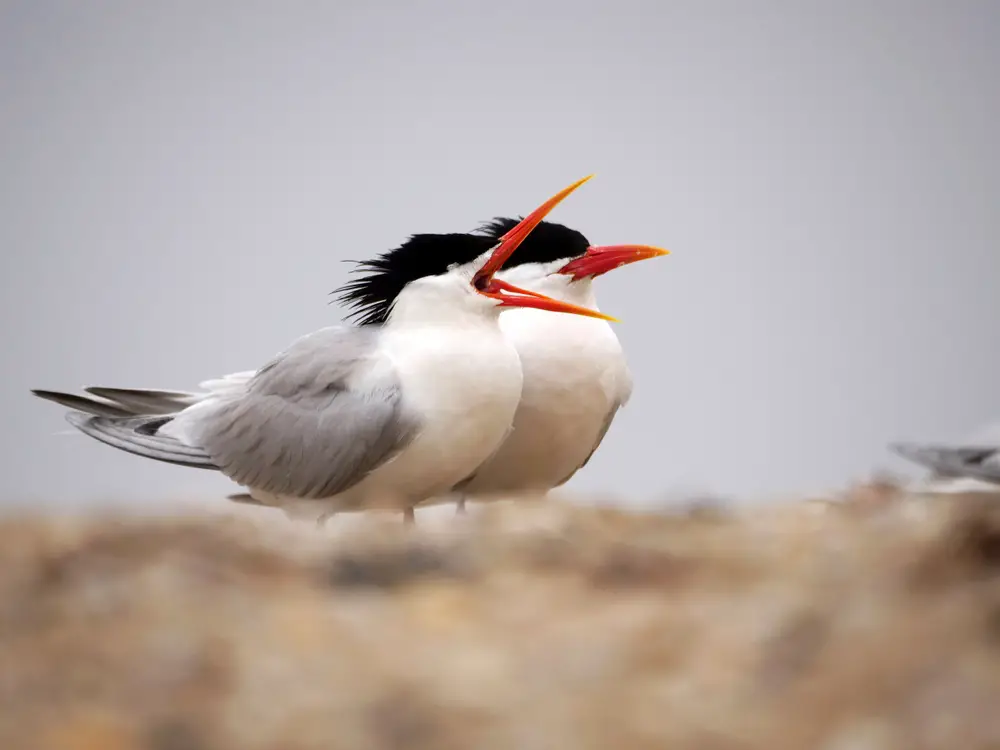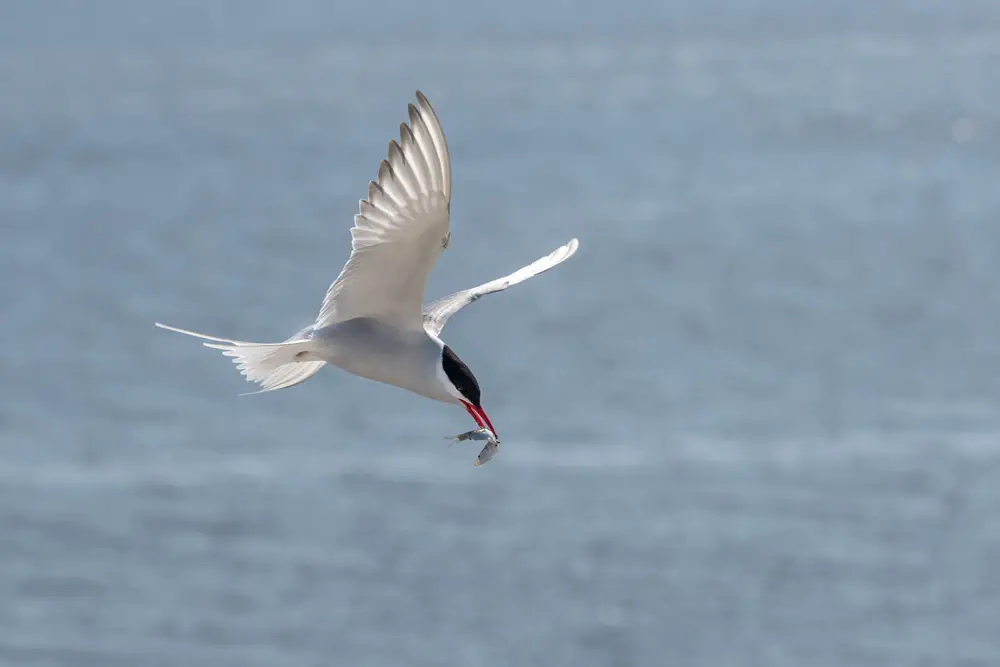The elegant tern (Thalasseus elegans) is a medium-sized seabird from the Laridae family. It inhabits estuaries and coastal lagoons of western North America and South America’s Pacific coast.
The bird has a black cap on its head that extends to just above its eyes; it also sports gray wings with white edges along the tips. Its body is predominantly white in color with black flight feathers at the base of its tail. In terms of size, this species typically averages between 30–35 centimeters in length with a wingspan measuring up to 70 cm across.
This species exhibits an interesting behavior when nesting due to their tendency to lay eggs together with other species of terns in mixed colonies usually located near shorelines.
An individual will have several nests within close proximity as they establish territories throughout breeding season which occurs during mid April through late June in most areas where they inhabit. Elegant terns are social birds often found foraging in flocks composed mainly of conspecifics but occasionally joined by other small sea birds such as gulls and skimmers.
In addition to their unique appearance and behavior, these birds play an important role within oceanic ecosystems by consuming various types of fish and invertebrates such as squid, shrimp, clams, and crabs while helping control local pest populations like mosquitoes.
As a result, conservation efforts must be made to ensure that healthy populations can continue being maintained around the world given how vital these birds are for maintaining ecological balance

Overview
The elegant tern is a species of sea bird found in the Atlantic and Pacific Oceans, as well as parts of Europe. It belongs to the Sternidae family, which includes all terns. The elegant tern has a long wingspan and can reach speeds up to 44 miles per hour when in flight. Its plumage varies from grey-brown to white with some black markings on its head and chest.
The elegant tern is an agile flyer with strong navigational skills that allow it to spend much of its life at sea. This habitat gives them access to a variety of food sources such as fish, crustaceans, mollusks, insects, plankton and more. They also use their sharp beak for catching prey while they are flying or swimming underwater.
This species of seabird is known for its graceful behavior when in flight and its characteristic call – a loud “kree-ah” sound – which echoes across oceans during mating season.
They can often be seen soaring high above the water’s surface looking for food or migrating southward during winter months. Overall, the elegant tern stands out among other species due to its features, characteristics, and behaviors that make it truly unique amongst its peers.
Appearance And Behavior
The elegant tern is a small bird with a length of 25-30 cm and wingspan of 55-60 cm. Its plumage consists of white feathers, black markings on the head, greyish back, long tail streamers and yellow bill. During courtship displays they develop striking white crests.
They feed mainly on fish and are very agile in flight due to their short tails and long pointed wings which enable them to make sudden turns and changes in direction at high speeds. When foraging for food, these birds can be found hovering over the water surface or diving into it from heights up to 10 m.
Elegant terns have been observed performing several courtship rituals such as bowing before each other during encounters at nesting sites, giving aerial displays by flying together in circles while calling out loudly, raising their crest feathers when perched next to potential mates, and preening one another’s feathers with their bills as part of mating ritual.
These activities usually occur shortly before breeding season commences throughout late spring through summer months. The nest itself consists of shallow depressions dug into sand beaches among vegetation surrounded by stones or pieces of driftwood used to build walls around the site for protection against predators or weather elements like wind or rain.
The species is known for its ability to migrate far distances across continents between summer breeding grounds in North America and wintering grounds located along both coasts of South America proving that this bird has great endurance and navigation capabilities allowing them to cover large expanses without difficulty.
Range And Habitat
The elegant tern has a large habitat range, extending from coastal areas in California to Mexico and Central America. It breeds along the west coast of North America southward into Baja California and spends its winters on both coasts of South America.
Its migration range is vast, with individuals flying all the way down to Argentina for wintering grounds. The nesting range of this species includes mudflats, sandbars, lagoons, islands and beaches located near water bodies such as estuaries or bays.
They often nest among other wading birds in mixed colonies. Elegant terns can also be found roosting at night in aggregations off shore or along the beachfront during summer months. As an opportunistic feeder they mainly prey on fish but have been known to consume crustaceans and insects when encountered.
This species faces many threats throughout its range, including human disturbance by recreational activities like boating and fishing which disturbs breeding adults and their young during crucial development stages.
Additionally, egg collecting poses a serious threat in some parts of their distribution area resulting in decreased reproductive success rates due to reduced clutch sizes over time.
Conservation efforts are important to ensure that these beautiful seabirds continue to inhabit our coasts well into the future. With proper management plans put into place it will help maintain healthy population numbers so we can enjoy watching them gracefully soar above us for years to come!
Diet And Feeding Habits
The elegant tern diet consists mainly of fish and invertebrates, with a range depending on the location. Fish make up the majority of their diet, which can include species such as anchovies, sardines, menhaden and mullet.
Invertebrates eaten by elegant terns usually include crabs, shrimps and other crustaceans. These items are generally taken from seabed areas in shallow waters near shorelines or estuaries.
In addition to these main food sources for the elegant tern, they will also feed on small insects when available. This may be done during migration periods if traversing over land masses.
The opportunity is used to supplement their diet while away from traditional habitats in marine environments. Birds tend to hunt singly or in pairs; however larger flocks have been known to form along shorelines where prey concentrations are high.
Elegant terns use various techniques while hunting including hovering above water bodies while scanning the surface for potential targets before diving into the water feet first at speeds exceeding 30 mph (48 km/h).
Once submerged they search around using tactile feeding methods until finding suitable prey items before resurfacing with meals firmly held within its bill that it then carries back to land or sea ice surfaces for consumption.
These birds possess an impressive array of skills enabling them to survive through harsh conditions and successfully locate food sources necessary for survival. Their ability to rapidly adapt has allowed this species of seabird to thrive across much of its natural habitat range despite some population declines due primarily to human interference in certain regions throughout its distribution area.
Breeding And Nesting Habits
The elegant tern is a unique and distinguishable species of seabird. These birds breed in colonies located on beaches or sandbars that are free from human disturbance. The Breeding season for the elegant tern typically occurs between April to August depending on geographic location.
When it comes to breeding habits, several behaviors have been observed amongst the elegant terns. Firstly, they build their nests by scraping out a shallow depression in sandy beaches and lining them with feathers or other debris found nearby.
Secondly, they perform many courtship displays such as sky pointing, bowing and dancing before mating commences. Thirdly, males will often fight over nesting sites to gain access to potential mates during the breeding season. Lastly, pairs establish feeding territories around their nest sites which they vigorously defend against intruders throughout the breeding period.
- In addition to these behaviors, the elegant tern exhibits some remarkable nesting behavior which includes:
- They lay eggs both day and night;
- Males will guard the nest while females fly away for food;
- Females may return after an hour or more with food to feed their mate;
- Both parents take turns incubating their eggs until hatching;
- Chicks begin leaving their nests within two weeks after hatching.
These observations demonstrate how adaptive these birds can be when attempting to raise chicks successfully in an ever changing environment. This also serves as evidence of why this species continues to survive despite significant threats posed by humans and climate change alike.

Migration Patterns
The elegant tern is a migratory species, which means that it undertakes seasonal journeys from one region to another. Every year, the birds migrate along flyways in search of food and suitable breeding grounds for nesting. During their migration, they cover thousands of miles and cross both land and sea boundaries.
| Migrating Area | Seasonality |
|---|---|
| Arctic | Summer |
| North America | Spring/Fall |
| Southern Africa | Winter |
Migration patterns vary widely among different groups of elegant terns depending on where they originate from and where they go to breed. For example, some populations travel south towards tropical areas during winter months while others stay within temperate regions all year round.
In addition, individual birds may also follow unique routes based on availability of resources or personal preference. Regardless of the route taken by an individual bird, each population typically follows a consistent pattern over its lifetime.
Elegant terns tend to leave their breeding sites shortly after chicks fledge in order to take advantage of favorable conditions elsewhere such as more abundant food sources or higher temperatures when approaching winter months.
This behavior helps them survive harsher weathers and provides vital nutrition for developing young ones until at least one successful breeding season has been completed before migrating again.
The timing of these events varies but generally occurs between late August to early October depending on location (and other environmental factors). Ultimately, this cycle ensures that generations are well-prepared for life beyond the nest and can continue with future reproduction cycles as necessary.
Conservation Status
The elegant tern is classified as a Vulnerable species on the IUCN Red List. This means that it faces a high risk of extinction in the wild, and is considered to be globally threatened. Populations have been reduced due to habitat loss, coastal development, predation by cats and dogs, fishing activities, oil spills and hunting for food.
In order to protect the elegant tern from further decline or possible extinction, conservation efforts must be taken immediately.
These measures include protecting nesting sites through proper management plans and monitoring programs; reducing water pollution which could lead to decreased prey availability; controlling predators such as cats and dogs; providing protection against illegal hunting; minimizing disturbance of birds during reproduction season; and decreasing human disturbances at nest sites.
Regulations should be put into place to reduce accidental entanglement with fishing nets or lines.
These actions would help ensure the future survival of this stunning seabird species for generations to come. It is essential that we take action now in order to safeguard their numbers so they can continue living alongside us in harmony with nature.
Conclusion
The elegant tern is a remarkable seabird species with unique characteristics that have captivated birdwatchers and ornithologists alike. Its distinct features, such as its striking black-capped head and eye-catching white plumage, make it an exceptional sight to behold.
The elegant tern’s range stretches widely across the world, inhabiting many coastal regions including parts of South America, Africa, Europe, North America and Asia. Preferring shallow waters near coasts or estuaries for their habitats, this species feeds mainly on fish by diving from the air into the sea below.
During breeding season they build nests in sheltered areas using materials gathered from around the beach area. The annual migration patterns of this species has been extensively studied over recent years; some individuals migrating thousands of miles between summer and winter quarters.
Despite its large distribution and generally stable population trend, threats from human activities can lead to localized declines which could affect future conservation efforts. As more people become aware of its beauty and ecological importance, steps should be taken to ensure that populations remain healthy so that we may continue to appreciate these amazing birds in the wild long into the future.
